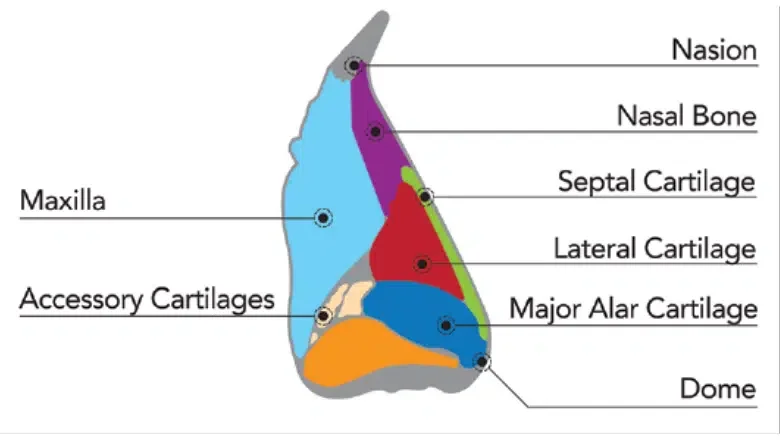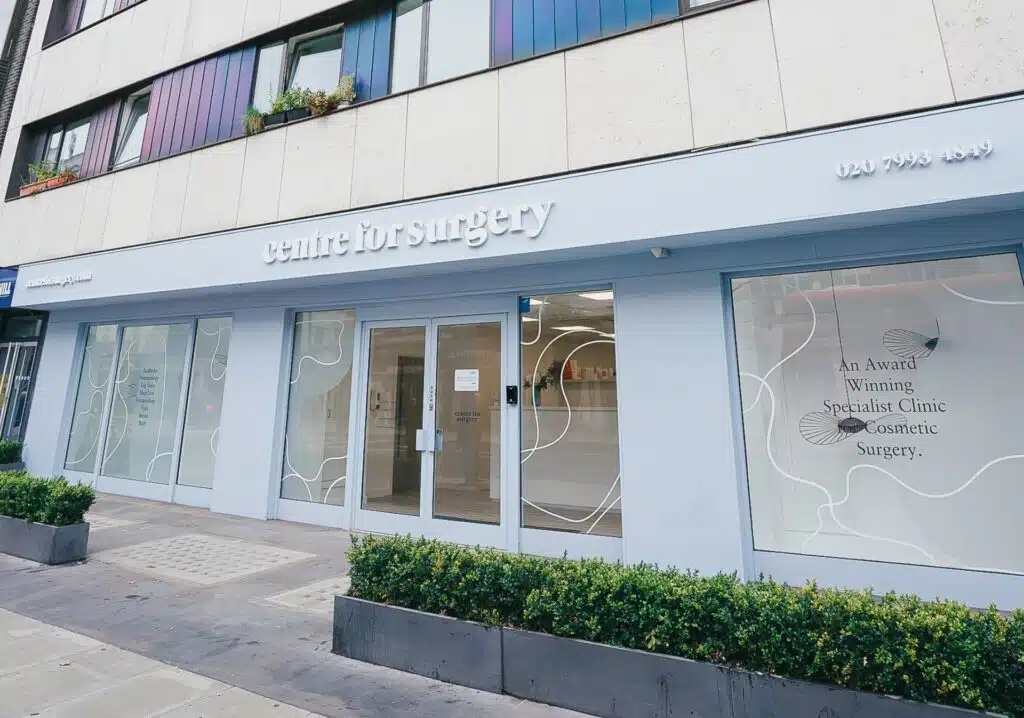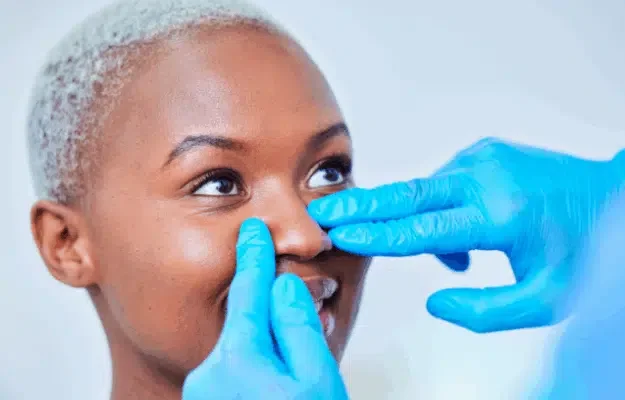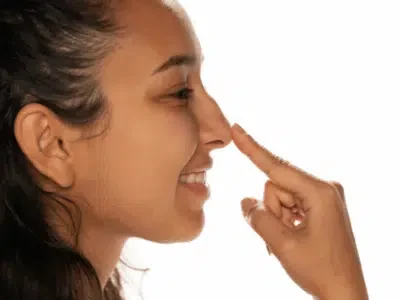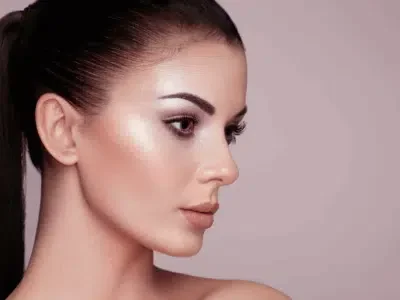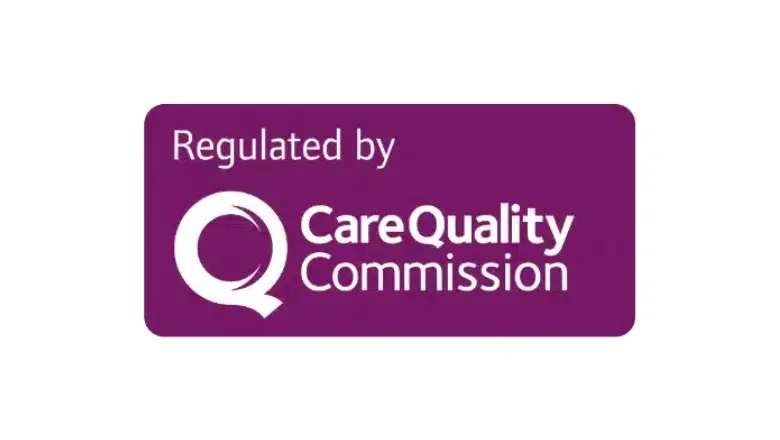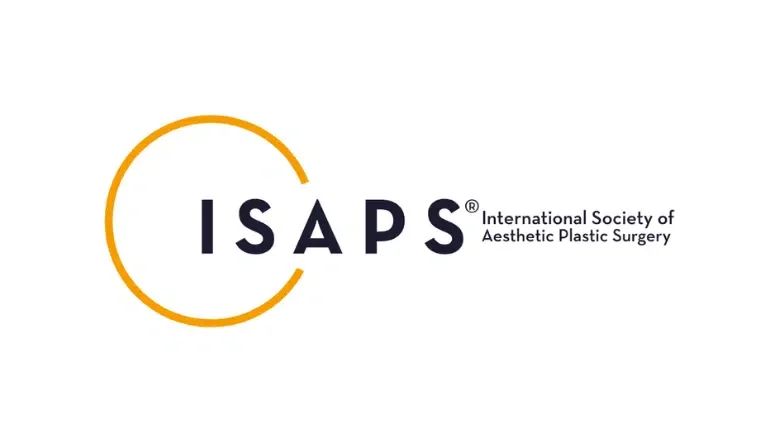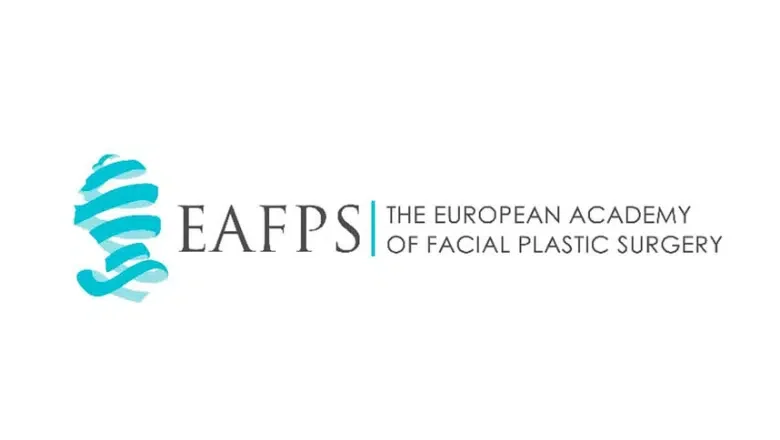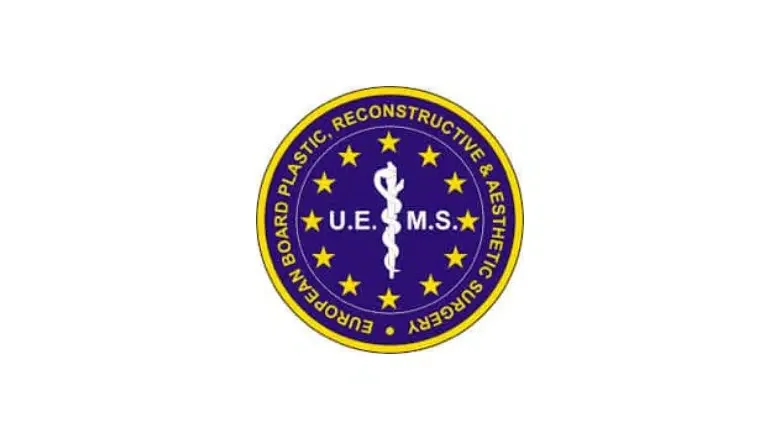Nose surgery is something that involves many different factors. So, we’ve put together an article to help you understand everything you need to know about the way the nose is built, the usual shapes of noses, common problems, and a list of words that might be useful to know. This will not just assist you in explaining to your surgeon exactly what you want but will also make it clearer what can and can’t be done through surgery.
The way your nose looks is a big deal when it comes to appearance and beauty. Everyone’s nose has its own unique shape, and a lot of people are not pleased with how their nose looks. Rhinoplasty is the name for a type of surgery that’s done to change the shape of the nose to make it look better.
RELATED: What Makes a Beautiful Nose?
Getting a nose job isn’t something simple, and it takes a really talented surgeon to get the results just right. At Centre for Surgery, our plastic or ENT (Ear, Nose, and Throat) surgeons will have to think about lots of things when they’re doing the operation. This is because every nose is unique, and each person wants their nose to look different. Your surgeon must take all these things into account to make sure that the shape of your nose fits what you want and looks as good as possible.
Anatomy of the Nose – What You Can See on the Surface
First, let’s talk about the surface anatomy, which means the parts of the nose that you can see, without looking at the inner structures that make it up. Here’s what you can see when you look at a nose:
- The Radix: This is the top part of the nose, right in the middle between your eyes.
- The Dorsum: You might hear this called the bridge as well. It’s the part of the nose that goes from the radix (the top part) down to the tip of your nose.
- The Columella: This is the straight piece that you can see between your two nostrils.
- The Alae: These form the sides of the nostrils. If you’re talking about just one side, it’s called an “Ala.” If you’re talking about both sides together, you use the plural, which is “Alae.”
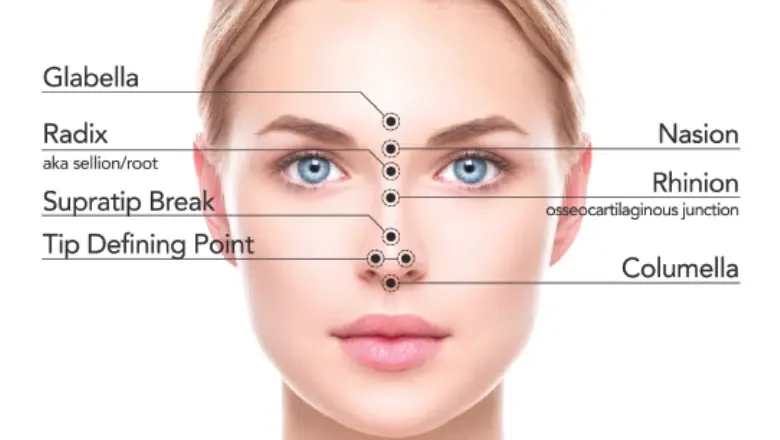
Anatomy of the Nose – What’s Below the Surface
Below the parts of the nose you can see (which we explained earlier), there are bones and cartilage that actually give the nose its shape. We can split the nose vertically into three sections. The top third is made of nasal bones, the middle third has what’s called the upper lateral cartilages, and the bottom third consists of alar cartilages:
- Nasal bones: These bones aren’t very hard and are often shaped or shaved during a nose job (rhinoplasty) to get the desired appearance. They are what give the bridge of your nose its particular shape and how far it sticks out.
- Upper lateral cartilages: This is a type of tissue that’s firm but not as hard as bone. It starts just under the nasal bone in the middle part of your nose. You can even feel it yourself, as it’s the soft, squashy part. These cartilages make sure the nostrils stay open and wide. If they’re weak, your nose might look like it’s pinched.
- Alar cartilages: These are really crucial because they help give the tip of your nose its shape. Surgeons often work on these cartilages during rhinoplasty. They are found under the tip of the nose, as well as under the columella (the part between the nostrils) and the alae (the sides of the nostrils).
- Nasal septum: This is like a wall in the middle of your nose that separates the right and left sides from each other. You might have heard the phrase “deviated septum.” This refers to an issue with the nasal septum.
Understanding these elements can be really helpful, especially if you’re considering any type of nose surgery. It gives you a better idea of what the surgeon will be working on to change the shape of your nose. It’s like having a map of what’s inside your nose!
Who Might Need a Nose Job?
Rhinoplasty, or what we commonly call a nose job, can be done for either cosmetic reasons or medical needs. Here’s a list of some problems with the nose that might make you think about having this type of surgery:
Problems with the Dorsum (Bridge of the Nose)
The dorsum is the area that runs from the top of your nose down to the tip. Ideally, it should be fairly straight with just a bit of curve. Here are some of the typical problems with the dorsum that might lead to someone having a nose job:
- Large dorsal hump: This is when the dorsum sticks out too much and is curved outward, forming a bump or hump. This common problem can be caused by the nasal bones and cartilages being too large.
- Wide nose: This could be that the nose is too wide at any point, whether it’s the upper part of the dorsum (called the dorsal bridge), the middle part (known as the dorsal base), the tip, or even the nostrils. You might feel that your nose is too wide in any of these areas, making it look out of proportion with the rest of your face.
- Under-projected dorsum: This is related to the dorsum being short and not sticking out far enough from the face. It often goes along with having an under-projected tip of the nose (which we’ll explain below).
- Saddle deformity: This can happen when a large dorsal hump has been over-corrected during surgery, and too much tissue has been removed. It makes the dorsum look like a ski slope, with an inward curve.
Problems with the Tip of the Nose
The tip of the nose is shaped by something called alar cartilages. These cartilages support the nostrils at the sides and help the tip to stick out in the middle. There are several problems that can affect the tip of the nose:
- Droopy tip: This occurs when the tip of the nose points downwards. It’s often caused by a large nasal septum (the wall that separates the nostrils) pushing the alar cartilage down, which makes the tip look droopy.
- Over-projecting tip: Sometimes referred to as a “Pinocchio Nose,” this is when the tip of the nose sticks out too far from the face. This can be due to the alar cartilages being too large.
- Under-projecting tip: This happens when the tip of the nose doesn’t stick out far enough. It can go hand-in-hand with either a dorsum that sticks out too much (a hump) or a dorsum that doesn’t stick out enough.
- Bulbous tip: This is when the tip of the nose appears too big or too wide. It can give the nose a rounded appearance.
- Boxy tip: If you look at a typical nose from below, it should look like a triangle, with the tip of the nose as the top corner and the alae (the sides of the nostrils) forming the other two corners. But if the nose looks more like a rectangle, it’s described as having a boxy tip.
Problems with the Alae (Sides of the Nostrils)
The alae are the sides of your nostrils, and they can have some issues that affect the appearance of the nose. Some of the problems related to the alae might include:
- Wide alae: This happens when the alae stick out too much to the sides, making the nostrils look overly wide from side to side. It can give the nose a broader appearance than desired.
- Notched alae (nasal flaring): This is when the alae are positioned higher than normal, so that the columella (the part between the nostrils) is visible from the sides. It can create what’s sometimes referred to as a “snarl” appearance.
- Asymmetric alae: This occurs when the right and left sides of the nostrils are not the same shape or size. It can make the nose look uneven.
These problems with the alae can be a concern for some people, affecting how they feel about the appearance of their nose. They may be inherited traits, or they may develop over time. Just like with the dorsum and tip problems we’ve discussed, alar issues can often be corrected through rhinoplasty.
Other Nose Problems
Apart from the issues related to specific parts of the nose, there can be other problems that affect the overall structure and function of the nose:
- Deviated Nose: A deviated nose means that the nose is leaning to one side of the face. This can happen if you have a deviated septum (the wall in the middle of the nose), deviated nasal bones, a deviated tip, or deviated upper lateral cartilages. Each of these deviations may need a different approach during surgery to correct the problem.
-
Airway Obstruction: If you find it difficult to breathe through your nose, there might be something blocking the way. This could be due to:
- A deviated septum, which can obstruct the nasal passages
- Enlarged turbinates, which are structures inside the nose that can become swollen and block airflow
- Or another problem such as nasal polyps that needs diagnosis by a specialist surgeon.
These additional problems might not just affect the appearance of the nose but can also impact its functionality, particularly in the case of airway obstruction.
Different Types of Rhinoplasty: Open and Closed Techniques
Rhinoplasty, commonly referred to as a “nose job,” can be performed using two different techniques: open rhinoplasty and closed rhinoplasty. Both techniques have their particular applications and advantages, and surgeons in the UK may use one or both depending on the individual’s specific needs and the part of the nose being addressed.
RELATED: Nose Surgery FAQs – Q&A about Rhinoplasty
Open Rhinoplasty
Open rhinoplasty is often chosen when the problem that needs addressing is in the tip of the nose or the alae (the sides of the nostrils). Here’s how it generally works:
- Incision: The surgeon will make a small cut in the skin of the columella, which is the area between your nostrils.
- Reshaping: Excess tissue is removed, and what’s left is reshaped to create the desired look.
- Closing: The incision is then closed, and usually, no visible scarring remains after the healing process.
This method provides the surgeon with better visibility and access to the underlying structures of the nose, allowing for more precise alterations.
Closed Rhinoplasty
Closed rhinoplasty or endonasal rhinoplasty, on the other hand, is typically chosen when the main issue is in the dorsum (bridge) of the nose. Here’s how this technique is usually performed:
- Incision: A small cut is made inside the nostrils, so the skin on the outside of the nose is left untouched.
- Reshaping: The surgeon will then work through this incision to reshape the dorsum of the nose, correcting any problems.
Since the incision is made inside the nose, there’s no external scarring, and recovery may be quicker.
RELATED: Types of Rhinoplasty
Choosing the Right Technique
Both open and closed rhinoplasty have specific advantages, and the choice between them depends on the problem being addressed and the surgeon’s expertise. Some surgeons might even combine the two techniques to achieve the best possible result.
RELATED: Open vs Closed Rhinoplasty
Your surgeon will discuss with you the most suitable method for your particular situation. By understanding the structure of your nose and the changes you desire, the surgeon can create a tailored plan that aligns with your needs. Whether it’s a more dramatic alteration or a subtle refinement, these techniques allow skilled surgeons to achieve excellent aesthetic results, enhancing the overall harmony of the face.
RELATED: Does A Nose Job Change Your Smile?
What to Expect After a Nose Job: A Guide to Recovery and Results
Having a nose job, or rhinoplasty, is a significant decision, and understanding what to expect during recovery is an essential part of the process. At Centre for Surgery, we pride ourselves on housing some of the leading rhinoplasty surgeons in the UK, and we’re committed to ensuring that our patients have a clear understanding of what the journey will entail.
Before the Surgery
Before undergoing surgery, you’ll have a consultation with one of our experienced surgeons. During this meeting:
- Understanding Your Concerns: The surgeon will discuss your concerns and what you don’t like about your nose.
- Explaining the Procedure: They will explain how they plan to make your nose more appealing and in proportion with the rest of your face, helping you to understand what can and cannot be achieved.
After the Surgery
Following the procedure, here’s what you can typically expect:
- Immediate Aftermath: You may experience discomfort, swelling, pain, congestion, and some bleeding during the first week or two. These are normal post-surgery effects and will gradually subside.
- Recovery Time: While the initial discomfort should diminish within a week or two, full recovery takes longer. Your nose may not settle into its final shape for several months.
- Follow-up Care: Regular follow-up appointments with your surgeon will be scheduled to monitor the healing process and address any concerns you may have.
- Realistic Expectations: It’s vital to maintain realistic expectations about the outcome of the surgery and the shape of your new nose. Our surgeons will work diligently to provide the aesthetic improvement you desire, but the results will vary based on individual factors.
RELATED: Recovery After Rhinoplasty – Top Tips
Is Rhinoplasty Worth it?
Having a rhinoplasty can lead to a significant improvement in both the appearance and functionality of your nose. It’s an investment in your self-confidence and well-being. However, patience is key, as full recovery and the emergence of the final result will take time.
RELATED: Is A Nose Job Worth It?
Our team at Centre for Surgery is dedicated to guiding you through this process, providing expert care and clear communication every step of the way. We aim to help you achieve the beautiful nose you’ve always wanted and an overall enhancement in your facial aesthetics, leaving you pleased with the results.
Before and After Photos of Nose Surgery: A Visual Guide to Real Results
Seeing nose job before and after photos can provide a powerful insight into the potential outcomes of nose surgery, including both rhinoplasty (reshaping of the nose) and septoplasty (straightening of the nasal septum). These photos are valuable visual aids to help you understand what can be achieved by skilled surgeons.
Real Patients, Real Results
Below are some before and after images of actual patients who have undergone nose surgery at our Centre for Surgery. These pictures represent the real results that can be accomplished through careful planning and skilled execution:
Case 1:

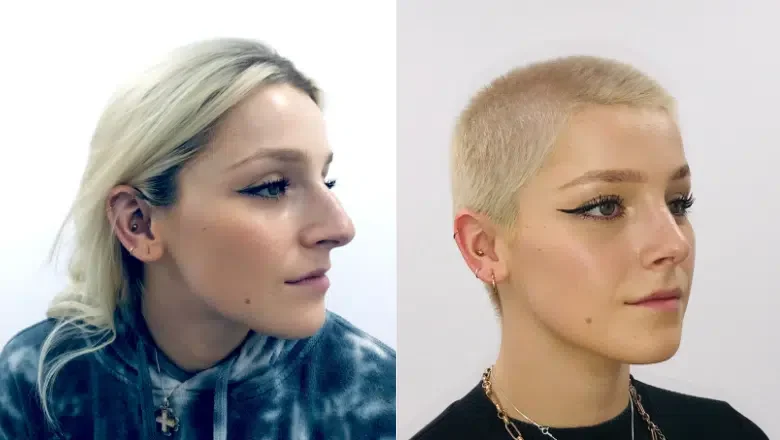
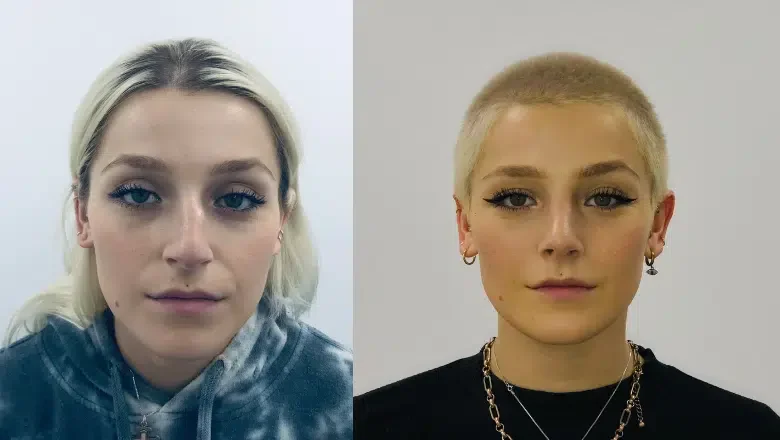

Case 2:

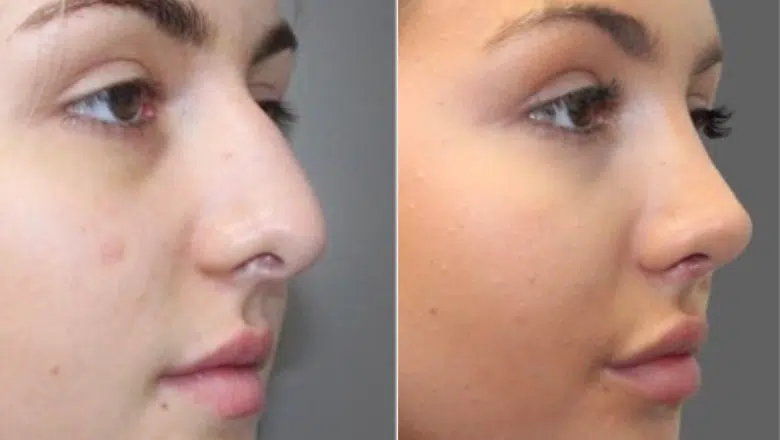
Case 3:
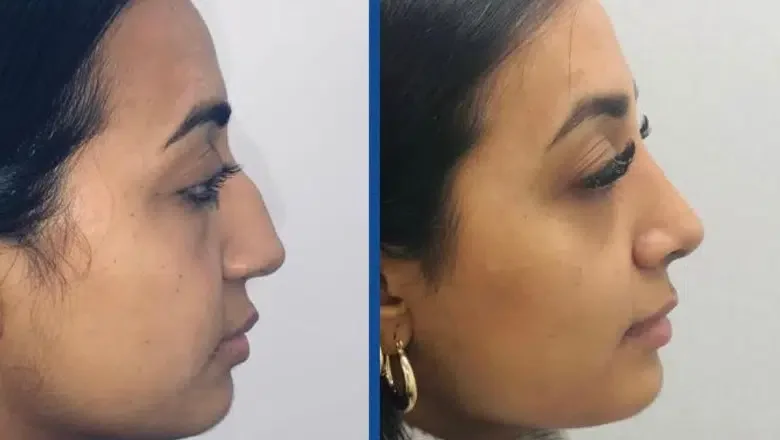
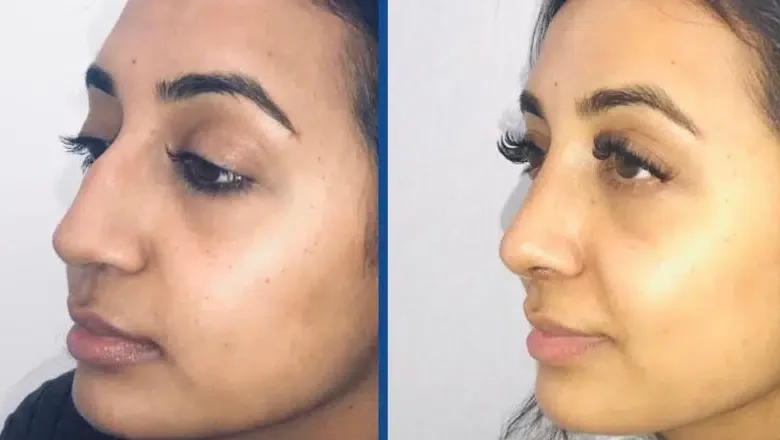

Comprehensive Rhinoplasty and Nose Surgery Glossary
Understanding the terminology can make the process feel less daunting when it comes to rhinoplasty and nose surgery. Here’s a comprehensive glossary of terms and phrases commonly used in the field:
- Alae (singular: Ala): The sides of the nostrils.
- Alar Cartilages: The flexible structures that give the tip of the nose its shape.
- Bulbous Tip: When the tip of the nose is overly large or wide.
- Closed Rhinoplasty: A surgical technique where the incisions are made inside the nose.
- Columella: The tissue that separates the nostrils.
- Deviated Septum: A condition where the wall that separates the nostrils is misaligned.
- Dorsum: The bridge of the nose.
- Droopy Tip: When the tip of the nose points downward.
- Enlarged Turbinates: Swollen structures within the nose that can cause breathing issues.
- Open Rhinoplasty: A surgical technique where an incision is made on the skin between the nostrils.
- Over-Projecting Tip: When the tip of the nose protrudes too far from the face.
- Radix: The uppermost point of the nose, located between the eyes.
- Rhinoplasty: A surgical procedure to reshape the nose.
- Septoplasty: Surgery to correct a deviated septum.
- Saddle Deformity: An inward curve of the bridge of the nose, resembling a ski slope.
- Under-Projecting Tip: When the tip of the nose does not protrude far enough from the face.
- Wide Alae: When the sides of the nostrils project too widely.
- Boxy Tip: When the tip of the nose appears more rectangular than triangular.
These terms are just the starting point, and your surgeon will help you understand any other terminology specific to your situation. Understanding these terms can empower you to communicate more effectively with your medical team and feel more in control of your journey.
At Centre for Surgery, we believe in clear and open communication, so feel free to ask us anything about the terms listed above or any other aspect of nose surgery. We’re here to provide information and support, ensuring that you feel confident and well-informed at every stage of the process.
Rhinoplasty at Centre for Surgery: Transforming Lives, One Nose at a Time
At Centre for Surgery, we understand that the decision to have rhinoplasty is more than just a cosmetic choice; it’s a personal journey to enhance your confidence, improve your appearance, and sometimes even address medical issues. Here’s why you should consider Centre for Surgery for your rhinoplasty needs:
A Team of Experts
Our surgeons are among the top rhinoplasty experts in the UK, boasting years of experience, extensive training, and a commitment to achieving outstanding results. Whether it’s a subtle refinement or a more dramatic change, our team will work closely with you to understand your goals and create a personalised plan tailored to your needs.
State-of-the-Art Facilities
We invest in cutting-edge technology and maintain the highest standards of safety and hygiene at our Baker Street clinic. Our operating rooms are equipped with the latest surgical tools, ensuring that procedures are carried out with utmost precision. Your comfort and safety are our top priorities.
Comprehensive Consultation
We believe that the success of a rhinoplasty procedure starts with a detailed consultation. Our surgeons will spend time with you, discussing your expectations, evaluating your nose’s structure, and explaining all available options. We want you to feel well-informed and confident about your decision.
Tailored Techniques
Whether it’s open or closed rhinoplasty, addressing the dorsum or the alae, our surgeons have the expertise to utilise various techniques. They combine their artistic vision with surgical skills to sculpt a nose that complements your face and enhances your natural beauty.
Aftercare Support
Rhinoplasty is not just about the surgery itself but also the care that follows. Our dedicated aftercare team will be with you every step of the way, providing guidance, support, and follow-up appointments to monitor your healing and ensure a smooth recovery.
A Commitment to Satisfaction
Our goal is to provide you with a nose that you love and that feels naturally yours. We take great pride in the happiness and satisfaction of our patients, and our before and after photos speak volumes about our success.
Visit Us Today
Considering rhinoplasty? We invite you to schedule a consultation at Centre for Surgery. Our friendly staff and world-class surgeons are here to answer all your questions and guide you on the path to a new you. Explore our website, view our real patient results, and discover how we can make your rhinoplasty dreams come true.
At Centre for Surgery, we’re not just changing noses; we’re transforming lives. Come and see why we are one of the most trusted names in nose surgery in the UK. Your beautiful new nose awaits!


